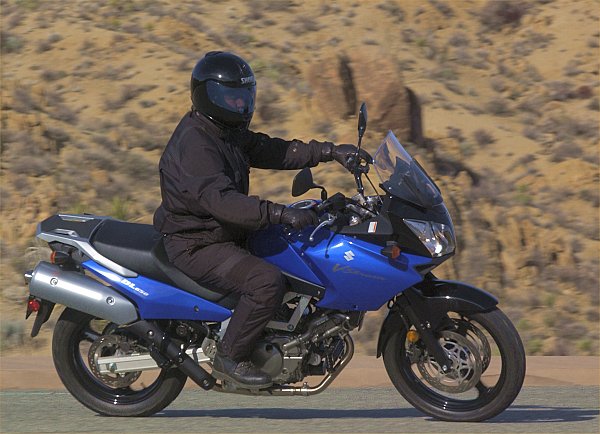
After spending plenty of time with the Suzuki V-Strom 1000 (it was our long term test bike, last year), we were very curious to sample the 650cc version introduced by Suzuki for 2004.
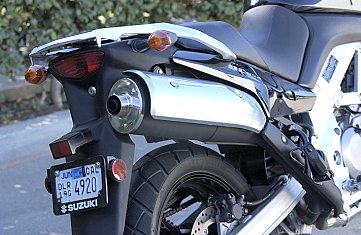
While the V-Strom 1000 is a bike we know and love (check out our numerous articles on the 1000 here, here, here, here and here) it is a bit tall and heavy (and intimidating) for some smaller, less experienced riders. The engine can also be considered overkill by many riders, who just do not need 1000cc of thrust.
With perhaps the best 650cc v-twin on the planet already in their parts bin, it made sense for Suzuki to introduce a smaller version of the V-Strom, lighter, more nimble, more fuel efficient, and less expensive. Enter the 2004 V-Strom 650.
The heart of the V-Strom 650 is its engine. Derived from the SV650 naked bike, for application in this middle-weight adventure tourer (or, as Suzuki prefers to call it, middle-weight sport enduro tourer), the SV650s 645cc DOHC v- twin engine received some changes. For discussion of the current SV650 fuel injected motor, take a look at our review of that motorcycle here. In the V-Strom, this thoroughly modern design has received revised cam profiles, a different air box and muffler . . . all aimed at improving output in the 4,000 rpm to 6,500 rpm range (Suzuki aimed for a five percent increase in output here).

Suzuki also effectively increased crank inertia by four percent in comparison with the SV650. Additionally, the V-Strom shares the same six-speed transmission with the SV, but with a lower final drive ratio.
Although claimed dry weight is 38 pounds less than the V-Strom 1000, several components are shared, including the basic twin-spar aluminum frame (which incorporates different mounting points for the 645cc engine). The swingarm is different on the 650, however, in order to balance rigidity of the overall chassis with the smaller motor.
Wheels and brakes are carried over from the 1000, as well, while the 650 features a front tire of different design from the 1000.
The suspension on the V-Strom 650 includes the same type of rear shock as the 1000, adjustable for preload (by convenient hand-turning knob, similar to the 1000) and rebound adjustment. The front fork is 43mm in diameter (the same as the 1000), and features preload adjustability, but it is not a cartridge design (as the 1000 is), but rather a “free-valve” design. Rake and trail figures are slightly different from the 1000.
The excellent dual front headlights are carried over from the V-Strom 1000, while the 2004 V-Strom 650 has a different shape to the turn signals, and the mirrors are also a different shape. A new instrument cluster provides plenty of information, including analog speedometer and tachometer, with digital odometer, dual trip meters, coolant temperature gauge, fuel gauge and clock. Indicator lights for neutral, turn signal activation and high-beam, as well as an oil pressure warning lamp, are also offered.

In addition to significantly lighter weight (and an even lighter feel, due to a much lighter crank inertia), the V-Strom 650 has a lower seat than the 1000 (20mm lower, to be exact) that is narrower at the thighs (making it easier to reach the ground for shorter riders).
Also new this year (on both the 650 and the 1000) is an adjustable windscreen. Three vertical positions are available (covering a range of 50mm), and the windscreen angle changes as it is raised (becoming more upright). A big, 5.8 gallon fuel tank, and excellent gas mileage, insure range in excess of 200 miles on a full tank of gas — ideal for touring.
Much of the remaining technical details are similar to, or identical to, those of the V-Strom 1000. So, let’s get right to our riding impression.
Sitting on the V-Strom 650 reveals a smaller, slimmer-feeling bike when compared with the 1000. The lower seat height is immediately noticeable, and the narrower seat allowed me to place my feet flat on the ground despite a short 31″ inseam. Rocking the bike side-to-side makes it clear the 650 is a much lighter bike than the 1000, with a significantly lower center of gravity (must be those shorter cylinders).
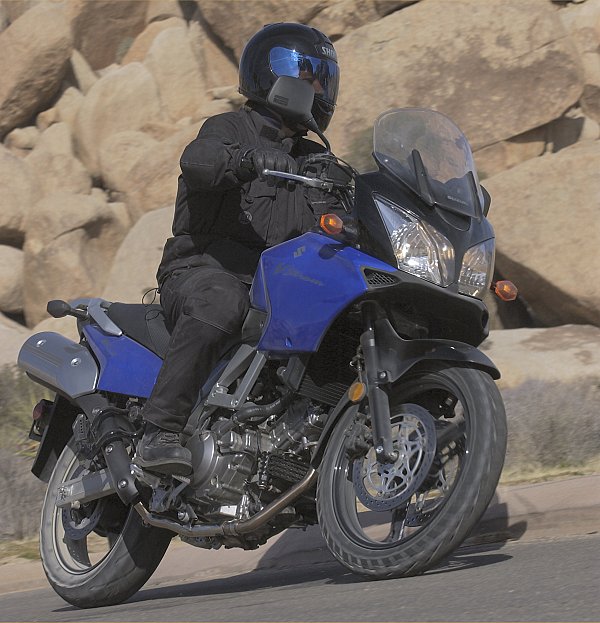
Once underway, I was struck by how smooth the 645cc v-twin engine is when compared with the 1000cc unit found in its bigger brother. Both v-twins are 90 degrees — meaning they have perfect primary balance. So, the 1000cc unit is not particularly buzzy, but its presence is felt much more than the 645cc version. The 650 feels almost electric smooth, particularly below 7,000 rpm.
Power delivery around town is very good. The motor does feel a bit punchier, and torquier, at low-to-mid-range rpms than the SV650. Later, I would rev the bike out to see if much was lost on top and, to my surprise, the V-Strom 650 pulls pretty hard all the way to 10,000 rpm (redline is at 10,500).
So, the engine is really nice. It is not the torque monster the 1000 is, but it is more than adequate for most circumstances, and plenty of fun.
It is in the handling department where the 650 most notably parts company with the 1000. The light, nimble feeling of the 650 is dramatically different from that of the 1000cc version. It certainly feels like a much greater difference than the 38 pound dry weight claimed by Suzuki. This undoubtedly has to do with a lower center of gravity, combined with lighter, reciprocating engine internals (including, primarily, the crank). In any event, the V-Strom 650 can slice in and out of traffic with a nimbleness the 1000 will never match.
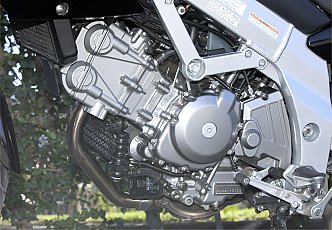
When we first got out on to the highway, the steering on the 650 felt somewhat vague. At our first stop, I tried a set-up change that was almost essential on the 1000, i.e, placing more weight on the front wheel by raising the rear of the bike with additional spring preload (or, in combination, raising the forks in the triple clamps). Although one of the journalists present raised the forks, I didn’t take the time to do this. I simply cranked in more preload (keep in mind that I weigh 210 pounds) and achieved a much more balanced, more precise steering feel. After this adjustment, the 650 handled beautifully, both in a straight line and through the twisties.
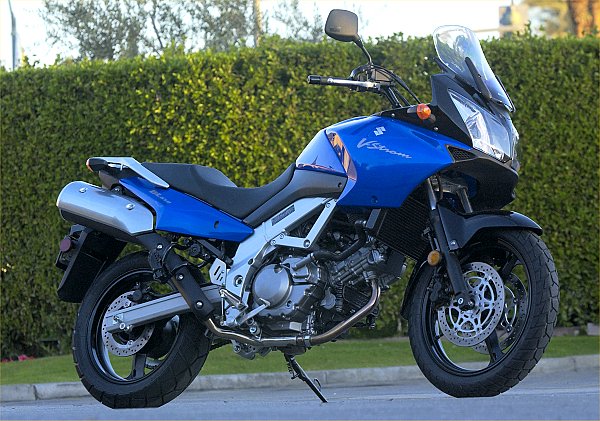

Our ride took us through Joshua Tree National Monument here in Southern California, and the weather was beautiful. Blue skies and a comfortable temperature combined with a really fun, versatile motorcycle to make for an enjoyable day.
The new windscreen proved to be a big improvement (at least on this initial ride) over the old design on the 1000. I only sampled the lower of the three positions, but wind buffeting was noticeably less than it was behind the stock screen on the 1000 last year.
Although I put close to 200 miles on the V-Strom 650 during this outing, we still want a unit from Suzuki for further testing. Specifically, we want to put the V-Strom through its paces with a passenger and some luggage to test its touring capabilities, and to just generally gain more seat time on this machine. Stay tuned for a more thorough ride review. In the meantime, note that the U.S. MSRP for the 2004 Suzuki V-Strom 650 is $6,599.





